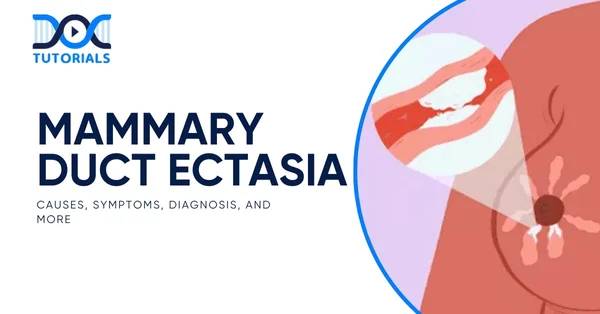Mammary Duct Ectasia: Causes, Symptoms, Diagnosis, and Treatment

Mammary duct ectasia is a non-cancerous condition that affects the milk ducts in the breast. It often causes swelling, pain, or discharge and is more common in women around middle age. Though it is not as widely known as other breast issues, it may resemble more serious ones, and therefore, a correct diagnosis will be needed.
It is useful for the NEET PG aspirants to know about the mammary duct ectasia causes, symptoms, and treatment for correct clinical judgement. This guide will give you a clear idea of this condition for exam preparation.
What is Mammary Duct Ectasia?
Mammary duct ectasia is a benign breast condition that leads to inflammation and thickening of the milk ducts. The breasts contain lobules (which produce milk), ducts (which transport milk to the nipple), and various other tissues. With age, the milk ducts naturally become shorter and wider. This change can cause breast discomfort or lead to a build-up of fluid that ultimately results in a blocked duct.
What are the Causes of Mammary Duct Ectasia?
The following are the causes of mammary duct ectasia:
- Infectious and Environmental Factors
Various infections and environmental exposures can influence the onset of mammary duct ectasia. Bacterial infections, especially those targeting breast tissue, may cause inflammation and obstruct the milk ducts. Exposure to certain environmental pollutants and irritants may also be a contributing factor to the development of the condition.
- Genetic and Autoimmune Factors
Genetic factors appear to have a potential role in the occurrence of mammary duct ectasia. People who have relatives with a history of disorders related to the breast may be at increased risk of developing this condition. Autoimmune diseases, which trigger inflammation throughout the body, might also be linked to ductal changes in the breast.
- Lifestyle and Dietary Influences
Diets rich in saturated fats and low in essential nutrients such as fruits and vegetables may increase vulnerability to breast conditions. Moreover, smoking has shown a clear association with ductal ectasia. Adopting a healthy routine, including balanced nutrition and regular physical activity, may help lower the risk.
What are the Risk Factors of Mammary Duct Ectasia?
Several factors may lead to the development of duct ectasia of breast:
- Gender
Although it mainly occurs in women, men may occasionally experience similar ductal changes.
- Age
The condition most often affects women between the ages of 40 and 60, typically around the time of menopause.
- Pre-existing Breast Conditions
Past experience of infections in the breast or any other related disorder affecting the breast can increase the possibility of getting duct ectasia.
- Geographic Location
Studies have shown that there is a possibility that women in certain geographical regions are more likely to develop cysts, probably as a result of environmental or lifestyle factors.
What are the Symptoms of Mammary Duct Ectasia?
The symptoms of mammary duct ectasia can vary based on its intensity. These are as follows:
- Nipple Discharge: A thick, sticky fluid may be released from the nipple, which often appears green or black in colour.
- Breast Pain: The affected breast may experience tenderness or persistent discomfort.
- Swelling: One may have swelling around the nipple due to the inflammation.
- Nipple Retraction: The nipple may begin to turn inward or appear pulled back into the breast.
- Redness or Warmth: Redness or warmth occurs around the nipples, which is considered an internal inflammation.
- Lumps: A lump can form in the breast tissue, and this can feel different compared to the surrounding tissue.
How to Diagnose Mammary Duct Ectasia?
Some of the ways in which healthcare professionals diagnose mammary duct ectasia include:
- Breast Examination
This is done by the doctor examining the breast tissue manually, usually while the patient lies down with one arm raised above the head. They also examine the presence of any lumps and look for the indication of nipple discharge.
- Ultrasound
In this imaging method, sound waves are used to create an image of internal breast structures so that the milk ducts and adjacent tissues can be seen better.
- Mammogram
It is an X-ray method used to determine any alteration in the breast tissue and provide an elaborate picture of the milk ducts.
- Magnetic Resonance Imaging (MRI)
MRI scans are performed in a magnetic chamber with the help of radio waves, providing a very detailed image of the inner structure of the breast.
- Biopsy
A small sample of breast tissue is extracted from the affected area and examined under a microscope. The doctor can take a biopsy when a lump appears in order to determine whether it’s cancerous.
What are the Mammary Duct Ectasia Treatment Options?
Treatment of duct ectasia is determined by the severity of the symptoms and their causes. There are a few alternatives when it comes to treating the condition:
- Medications
In case of the identification of infection, doctors might prescribe antibiotics. Other drugs, such as anti-inflammatory drugs, can be utilised, which alleviates the pain as well as the swelling of the breast tissue.
- Surgical Interventions
Surgery can be done in case of persistent, severe, and recurring symptoms. This usually involves removing the affected milk duct to provide lasting relief.
- Lifestyle Changes
Adopting a balanced diet, avoiding tobacco use, and managing stress levels can positively influence breast health and potentially reduce flare-ups.
- Warm Compresses
This can help to lower the discomfort and inflammation by applying gentle heat to the affected area.
- Alternative Therapies
Some individuals claim to get relief from their symptoms using such practices as acupuncture or herbal medicine. Still, it is recommended to address a medical expert before choosing alternative treatment methods.
What are the Different Ways to Prevent Mammary Duct Ectasia?
Although it may not be possible to prevent all cases of mammary duct ectasia, certain measures can help lower the risk and support breast health:
- Vaccination
Keeping vaccinations up to date can reduce the likelihood of infections that may lead to inflammation in the breast ducts.
- Breast Hygiene
Good hygiene may decrease the risk of getting bacterial infections that may lead to the development of duct ectasia.
- Healthy Diet
Eating a balanced meal with loads of fruits, vegetables, and good fats can help to enhance the functionality of the breast and decrease the likelihood of its associated diseases.
- Lifestyle Adjustments
Engaging in regular physical activity, managing stress effectively, and avoiding tobacco use can improve overall health and support breast wellness.
FAQs About Mammary Duct Ectasia
- How is mammary duct ectasia identified?
Mammary duct ectasia is typically diagnosed by a combination of diagnostic and imaging techniques by doctors. The initial steps involved are a thorough medical history and physical review, followed usually by imaging procedures. In some cases, additional tests like ductography or a tissue biopsy may be required to confirm the diagnosis.
- What steps can help reduce the risk of mammary duct ectasia?
The risk of developing mammary duct ectasia could be reduced by observing good breast hygiene and getting the required vaccines, as well as leading a healthy lifestyle through frequent exercise and a balanced diet.
- Does mammary duct ectasia pose a serious health risk?
Although mammary duct ectasia is a non-cancerous condition, it can result in complications if not properly managed. Ongoing symptoms should be evaluated by a medical professional to avoid further issues and ensure appropriate treatment.
- What noninvasive options are available for managing symptoms of mammary duct ectasia?
Using soft, absorbent pads within a bra will greatly help in reducing sensation in the affected area and also prevent stain marks on clothing. A warm compress application on the affected breast can give relief and stimulate the drainage of fluids.
- Is there a chance of mammary duct ectasia recurring after treatment?
Mammary duct ectasia may return in certain cases, especially when the root cause has not been effectively treated. Nevertheless, with proper medical care and regular follow-up, the chances of recurrence remain low.
Conclusion
Mammary duct ectasia is a benign condition of the breast that may present with symptoms similar to more serious illnesses. Recognising its clinical features, understanding the causes, and knowing the diagnostic and treatment options are important for effective management and improved patient outcomes. Early identification and proper care can prevent unnecessary complications.
As a NEET PG aspirant, mammary duct ectasia is an issue you should understand in detail to make an accurate diagnosis during clinical practice. DocTutorials provides high-quality study materials and professional advice that can be of great help in preparing for your examinations.
Explore our NEET PG course to strengthen your medical knowledge and achieve your academic goals!
Latest Blogs
-

NEET PG Exam 2025- Date, Pattern, Marking Scheme, Subject Wise Weightage, and Exam Mode
NEET PG Exam 2025 is the ultimate gateway for medical graduates aspiring to pursue postgraduate courses in medicine, including MD,…
-

INI CET Exam 2025: Your Roadmap to Success – Key Topics, Strategies, and Lessons from Last Year’s Papers
The INI CET exam is more than just a test; it’s a significant milestone for many medical students aiming to…
-

INI CET Exam Success: Previous Year Question Papers & Ultimate Guide – INI CET PYQ
One can feel overwhelmed while preparing for the INI CET (Institute of National Importance Combined Entrance Test). A vast syllabus,…




